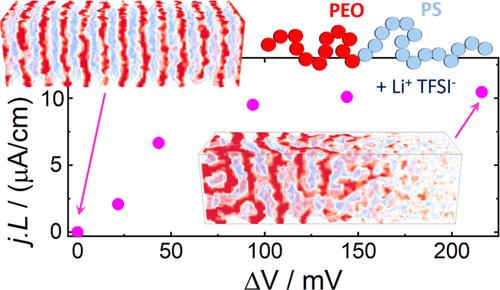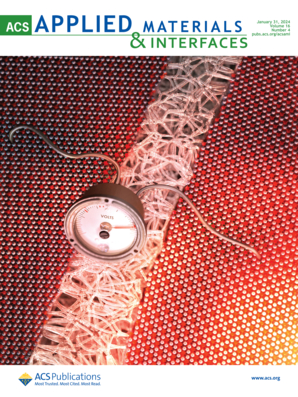Morphology–Transport Coupling and Dissipative Structures in PEO–PS+LiTFSI Electrolytes In-Operando Conditions
IF 8.3
2区 材料科学
Q1 MATERIALS SCIENCE, MULTIDISCIPLINARY
引用次数: 0
Abstract
A Single-Chain-in-Mean-Field (SCMF) algorithm was introduced to study block copolymer electrolytes in nonequilibrium conditions. This method self-consistently combines a particle-based description of the polymer with a generalized diffusion equation for the ionic fluxes, thus exploiting the time scale separation between fast ion motion and the slow polymer relaxation and self-assembly. We apply this computational method to study ion fluxes in electrochemical cells containing poly(ethylene oxide)-polystyrene (PEO–PS) block copolymers with added lithium salt. Blocking of the anion fluxes by the electrodes in-operando conditions polarizes the cells and results in an inhomogeneous salt-concentration profile. This gradient of salt concentration triggers lamellae-to-disorder and disorder-to-lamellae transitions near the electrodes, in good agreement with previous experimental observations. The effects of the selectivity of the electrode surface, the salt concentration and the voltage applied to the cell are systematically studied. For PEO-selective surfaces, the lamellae parallel to the electrode that forms at low applied potentials transition to a bicontinuous morphology at high applied potentials in order to allow ion transport through the insulating PS layers. The formation of this dissipative structure, which is unexpected considering the equilibrium behavior of the material, is in line with the principle of maximum entropy production. In summary, the transport and morphology in PEO–PS electrolytes are strongly coupled: ionic currents influence self-assembly, which in turn modulates the ionic fluxes in the cell.

求助全文
约1分钟内获得全文
求助全文
来源期刊

ACS Applied Materials & Interfaces
工程技术-材料科学:综合
CiteScore
16.00
自引率
6.30%
发文量
4978
审稿时长
1.8 months
期刊介绍:
ACS Applied Materials & Interfaces is a leading interdisciplinary journal that brings together chemists, engineers, physicists, and biologists to explore the development and utilization of newly-discovered materials and interfacial processes for specific applications. Our journal has experienced remarkable growth since its establishment in 2009, both in terms of the number of articles published and the impact of the research showcased. We are proud to foster a truly global community, with the majority of published articles originating from outside the United States, reflecting the rapid growth of applied research worldwide.
 求助内容:
求助内容: 应助结果提醒方式:
应助结果提醒方式:


